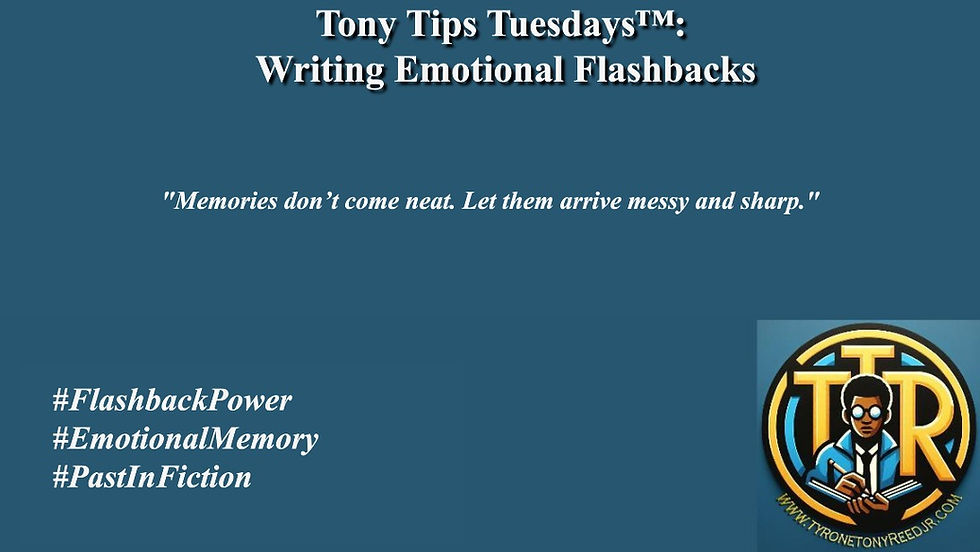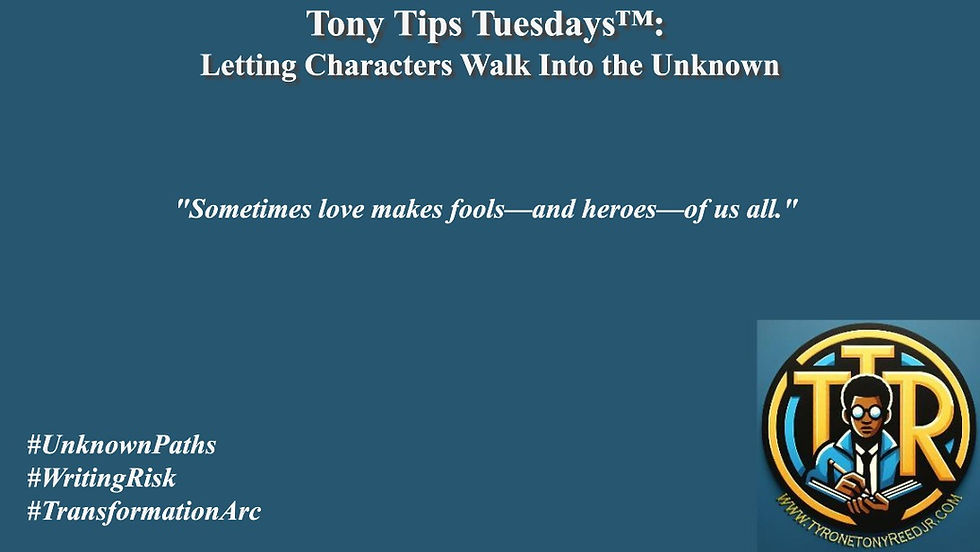Tony Tips Tuesdays™: Avoiding Info Dumps
- Tyrone Tony Reed Jr.

- Sep 2
- 6 min read

Whether you’re building a new world, introducing a complex backstory, or creating high-stakes conflict, the temptation to explain everything right away is real. But dumping too much information too quickly can kill your story’s momentum, overwhelm your reader, and break immersion.
Today’s Tony Tips Tuesdays™ is all about avoiding info dumps—and instead, mastering the art of showing, sprinkling, and layering information throughout your story.
📚 What Is an Info Dump?
An info dump happens when a writer pauses the narrative to explain everything the reader needs to know in one overwhelming block.
It’s often:
An exposition-heavy paragraph (or five)
A character giving an unrealistic monologue
A flashback with too many details
A chapter that reads like a history book
And while it may feel helpful… it’s often the fastest way to make a reader tune out.
📌 Tony Tip: If you feel like you’re explaining the story more than telling it, you might be info dumping.
🧠 Why Writers Info Dump
Let’s be honest. Most of us have done it. And here’s why:
You’re excited about your world or plot and want readers to know everything.
You think readers need all the background info to understand the current scene.
You haven’t figured out how to show the world through the characters’ experiences.
You're afraid readers will get confused without context.
But here’s the truth: Your readers are smart.They’re willing to wait. They want to discover things gradually. They want to experience the world, not be handed a textbook on it.
📌 Tony Tip: Let your readers catch up—don’t carry them.
🧱 What an Info Dump Looks Like
Let’s break down some examples:
🔴 Bad Example (Info Dump):
“In the year 2245, the United Nations disbanded after the Water Wars. The planet was divided into sectors, each ruled by independent coalitions. The main character, Ayla, lives in Sector 7, which is known for its mining operations and harsh climate. Her father, a rebel scientist, was exiled by the Coalition Council before she was born…”
This might be interesting in context, but delivered like this, it’s dry, overwhelming, and detached. The reader doesn’t know why they should care.
🟢 Better Example (Woven Into Narrative):
Ayla adjusted her cracked goggles and scanned the dust storms swirling above Sector 7’s cliffs. They said her father once predicted this chaos—before the Council exiled him, before the Water Wars turned the skies copper red.
This version shows us the world through Ayla’s eyes. It teases history without halting the story. It adds emotion and perspective.
📌 Tony Tip: If your paragraph sounds like a Wikipedia entry, it probably needs trimming.
🧠 Tools for Avoiding Info Dumps
So how do you avoid them while still giving readers what they need?
Here are seven proven strategies:
1. Start With the Character, Not the World
Readers care most about the people in your story. The plot, world, or timeline only matter because of the emotional impact on the characters.
Instead of:
“The kingdom of Elriya has ruled the Five Lands for 400 years…”
Try:
“Princess Nyla glanced at the golden Elriyan seal etched into the palace gates—400 years of control, and it still made her stomach twist.”
This builds world context while keeping the character front and center. Her reaction is the reader’s bridge into the story.
📌 Tony Tip: The reader should discover the world the same way your character does—moment by moment.
2. Show, Don’t Tell
One of the oldest and most effective writing principles. Show the consequence, not just the cause.
Don’t just say:
“He was angry.”
Say:
“He slammed the door so hard the walls shook.”
Don’t just say:
“Her people were starving after the war.”
Say:
“Children pressed their faces to bakery windows, watching crumbs fall like gold.”
Revealing emotions, history, or world-building through sensory cues and behavior makes the writing more immersive.
📌 Tony Tip: Let your scenes carry the weight of the backstory.
3. Use Dialogue With Purpose
Dialogue is one of the most powerful tools in your storytelling arsenal. It can build tension, reveal character, and sneak in background details without breaking the flow.
But beware of turning characters into infodump machines.
Avoid:
“As you know, Captain, ever since the solar collapse five years ago, the Earth’s crust has been unstable.”
That sounds unnatural and forced. Instead:
“The ground’s splitting again,” she muttered. “Just like after the collapse.”
This works because it respects what the characters already know, while still giving the reader a breadcrumb.
📌 Tony Tip: Dialogue should sound real—even in fantasy.
4. Drip Feed the Details
Not everything needs to be explained in Chapter One. Or Chapter Two. Or even at all.
Imagine your reader as a detective:
Leave clues in what your character notices.
Reveal backstory through habits, fears, and reactions.
Let world rules emerge naturally from action and conflict.
This builds trust and keeps your reader invested.
📌 Tony Tip: Think of your story like seasoning—sprinkle, don’t pour.
5. Flashbacks With a Purpose
Flashbacks are a powerful tool—but they must serve the story.
Don’t insert a flashback just to dump backstory. Instead, use them to:
Reveal emotional trauma or turning points
Explain current motivations
Deliver a plot twist or shocking reveal
Always tie a flashback to a present-day decision or dilemma.
📌 Tony Tip: A flashback should answer a question your reader is already asking.
6. In-World Context Clues
Don’t tell us about the world. Let the world speak for itself.
Instead of:
“The kingdom uses magic stones to power their homes.”
Try:
“Kiva slipped the last glowing shard into the hearth. The room sparked to life, shadows dancing along the stone walls.”
Let the reader see how the world functions. Let them experience the culture, customs, and rules in action.
📌 Tony Tip: World-building should feel lived-in, not labeled.
7. Trust the Reader
This might be the hardest tip of all—but it’s essential.
You don’t have to explain everything.
Let readers infer details from tone and behavior.
Use pacing and mystery to make them ask questions.
Trust that they will pick up the breadcrumbs you leave behind.
The best stories don’t hand over answers—they invite discovery.
📌 Tony Tip: Never underestimate your audience—they’ll meet you halfway.
🌟 Quick Tips to Keep the Flow Natural
Begin scenes in motion, not in explanation.
Cut anything the character wouldn’t logically think about in the moment.
Anchor big reveals to emotional beats or turning points.
Let subtext carry what exposition often tries to explain.
Revisit your draft and highlight exposition-heavy paragraphs. Can you show them instead?
🔍 Common Types of Info Dumps—and How to Fix Them
Type | What It Looks Like | Fix |
Prologue Dump | Pages of backstory before the story starts | Cut or weave it into action |
Dialogue Dump | One character talks for a whole page | Break it up with reactions and setting |
History Dump | Paragraphs about past wars, leaders, systems | Sprinkle it throughout dialogue or symbols |
Tech Dump | Describing every mechanism in sci-fi | Only describe what the character interacts with |
Setting Dump | Describing the entire city in one go | Focus on details that affect the current scene |
💡 Writing Prompts to Practice With
Write a scene where a character learns a secret—but only through observing, not being told.
Rewrite a backstory-heavy paragraph using only action and dialogue.
Introduce a new world or system without any exposition—only through character behavior.
Drop one major clue in the middle of a high-action scene. Let it surprise the reader and the character.
📌 Tony Tip: Backstory is most powerful when it surprises us at the right moment.
🧰 Final Thought: Discovery Is Part of the Journey
Think of storytelling like a puzzle. You don’t dump the pieces out already assembled. You let your readers put it together—piece by piece.
Give them something to uncover. A reason to keep reading. A trail to follow.
Don’t just tell your story. Let your reader experience it.
📌 Tony Tip: When your reader turns the page because they want to know more—not because you told them everything—that’s storytelling.
📝 Want to See This in Action?
The S.O.L.A.D.™: Soldiers of Light Against Darkness™ series is filled with layered revelations, slow-building tension, and character-led discovery. Every detail, from past battles to current powers, is revealed through action, dialogue, and emotion—not dumped in exposition.
Want to experience it for yourself?
🔥 Get your autographed copies of Book I and Book II directly from me at:👉🏾 www.tyronetonyreedjr.com/the-shop
Readers don’t just read S.O.L.A.D.™—they live it.



Comments